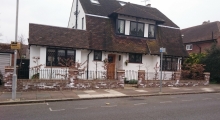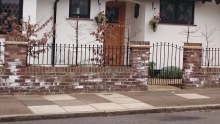K-Stone Limited
BRICK & STONE Repair and Restoration Specialists
White staining on new brick wall caused by salt deposits
|
It is very common for white patches to appear on a brand new wall, especially external brickwork as shown on these pictures. Such white marks on the brickwork are caused by effect called Efflorescence. There are a different types of efflorescence which can be caused by various factors: Primary efflorescence is typically caused on brick walls by the initial cure of cementous products. Secondary efflorescence is caused by external influence to the concrete such as salt deposits on bridges and parking garages as a result of applying road salt in the winter, continuous water leaks, etc. There is a lot of reading on the internet about Efflorescence, hence in this article I will only explain the Primary efflorescence in newly built external walls, which is important to the stonemasonry and external restoration business. |
Problem
White patches or white marks start appearing shortly after a new external wall is built. Build-up of such white patches may continue for a couple of years until it stops (don’t worry - it will eventually stop).
Why it happens
These white patches are salt deposits brought with the building materials which were used (the sand and most often the bricks themselves). When the wall dries after rain, the evaporation of water drives the salts out of the wall and they build up on the surface resulting in these white marks. With time all the salts will be driven out and the efflorescence will stop, but that may take a few years.
Remedy
Any white patches can be easily brushed off when the wall is dry. There are also cleaning materials to remove the salts and frankly speaking they are all weak acids similar to vinegar. Therefore if you want to clean those white patches yourself, brush them off when the wall is dry, and then treat the wall with white vinegar diluted in water.
Prevention
Any builder should be aware of admixtures that chemically react with the salt based impurities in the mortar when Hydrogen is present. The reality however is that very few builders would really use them due to the low severity of the problem (as mentioned above, these can be easily brushed off, and treated with vinegar). Such additives would produce a chemical reaction which would fuse the sodium chloride converting it into non-sodium chemicals and other harmless matter. The clever bit with using mortar additives is that they require the presence of hydrogen, hence the additives will stop reacting when the wall is dry, and begin reacting again once the wall is exposed to water again.
Alternative preventative for porous materials such as render or brick is to apply an impregnating hydro-phobic sealer coating to the wall. Such sealer will penetrate the wall deeply enough to repel any water and dissolved salts well away from the surface. Unfortunately such impregnation isn’t long lasting in climates with freezing temperatures as the sealant cracks during the freeze-thaw cycles.
What we recommend
Efflorescence is a minor issue with a straight forward remedy, but why waste effort if it can be prevented. We are very conscious when we mix our mortar which is always according to the particular application. We always use additives to the mortar in order to achieve best quality and longest life of the work. I strongly recommend the use of preventative additives to the mortar mixes and if you are having a brick fence in your plans, always ask your builders to use additives to the mortar mix to prevent efflorescence.
Please note that despite using additives to the mortar, in some cases efflorescence may still occur, but at least it will be in a much reduced severity.



Add new comment